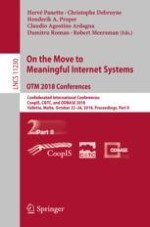2018 | Book
On the Move to Meaningful Internet Systems. OTM 2018 Conferences
Confederated International Conferences: CoopIS, C&TC, and ODBASE 2018, Valletta, Malta, October 22-26, 2018, Proceedings, Part II
Editors: Hervé Panetto, Christophe Debruyne, Henderik A. Proper, Dr. Claudio Agostino Ardagna, Dumitru Roman, Robert Meersman
Publisher: Springer International Publishing
Book Series : Lecture Notes in Computer Science
